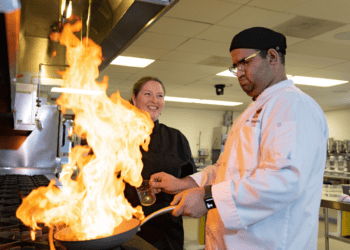Orange County Community Colleges Tackle Food Insecurity Feature Story
February 26, 2019

It’s one thing to be hungry for a new career, and quite another to
just be hungry.
But according to a December 2018 report from the US Government
Accountability Office (GAO), that’s exactly what many college students are.
Not surprisingly, the number of food insecure students tends to be
higher at community colleges and trade schools, where students are more likely
to be single parents, already receiving federal food-assistance benefits, or
first-generation students.
Because students suffering from food insecurity have consistently
lower rates of educational success, food insecurity is also an issue of student
equity. In response, the California State Legislature passed the Hunger-Free
Campus Initiative (Assembly Bill 453) which was introduced by the California
Community Colleges Chancellor’s Office in 2017 to support the installation of
food pantries and food insecurity programs across the state.
Orange County’s community colleges were quick to respond.
“The idea behind [our food pantry was] that it could be a one-stop
location for students who need immediate help, such as those experiencing food
insecurity or homelessness,” writes Orange Coast College Student Equity
Coordinator and Homelessness Liaison Maricela Sandoval in press materials. “In
addition to building a larger food storage area, we’ve created a space where
representatives from our partner organizations, such as CalFresh, can meet with
students to see if they qualify for aid.”
Across Orange County, funding from the Hunger-Free Campus Initiative
has led to similar programs at such community college campuses as Coastline,
Golden West, Santiago Canyon, Cypress, Fullerton, and North Orange Continuing
Education. In all cases, the growing number of participating students not only
speaks to the effectiveness of the programs, but also reveals the ubiquity of
the problem.
Food insecurity is defined as the “lack of reliable access to
sufficient quantities of affordable, nutritious food,” and its negative effects
on student success are significant, according to Hunger on Campus: The Challenge of Food Insecurity for College Students,
a national study on food insecurity published in 2018.
In the study, 1 in 4 community college students met the definition
of being food insecure. Significantly, 55 percent of these students reported
not being able to buy textbooks and 25 percent reported dropping a class.
“In spring, we were seeing 100-150 students a day,” says Sandoval,
whose Pirate’s Cove Food Pantry and Resource Center opened in January of 2018.
“This fall, that number has grown closer to 300 students a day, when we’re open
all day. Sometimes, we have lines of students waiting for their turn.
“We collect a ton of food, literally.
And there is never enough.”
The Hunger on Campus study
also found that nontraditional students, first-generation students, and
students of color were more likely to be affected than their classmates. Given
these statistics, it’s not surprising that the issue of food insecurity is of
particular importance to those in career education, where students often come
from these kinds of backgrounds.
“NOCE students, especially re-careering adults, are greatly affected
by food insecurity,” says Valentina Purtell, Provost of North Orange Continuing
Education. “Hunger impacts students’ ability to concentrate in class and
persist in their studies.
“Last year, NOCE participated in the national survey conducted by
the Hope Center at Temple University. The survey evaluates the extent of basic
needs, specifically homelessness and food insecurity. We are the only noncredit
institution participating in this survey, but I believe the results will be
reflective of many other noncredit and adult education programs.”
This survey, published as “Campus Food Pantries: Insights from a National
Survey,” included 262 participating institutions and was the first-ever
national survey of campus food pantries. According to the report, its purpose
was “to deepen our understanding of campus pantries by exploring the many ways
that these programs are being implemented.”
Some statistics of note include the fact that 36 percent of
participating schools serve more than 300 individual students a year, with a
full 15 percent responding that they served more than 1,000. The survey also
helps identify specific challenges and areas of need. For example, 40 percent
of pantries reported having insufficient funds, 25 percent reported having
insufficient food, and 17 percent said they lack volunteers.
In addition to offering fresh and canned food, many of these
pantries also serve as resource centers, providing guidance and support to
students who are having trouble meeting their basic needs. While the food
itself is often provided by donations and partnering organizations like Second
Harvest, state funding has been instrumental in sustaining the organizational
requirements of such programs.
For more information about food pantries and other basic needs
services, please visit your local Orange County community college’s website.




